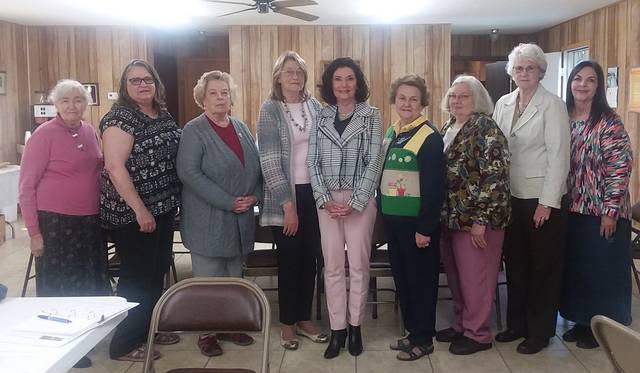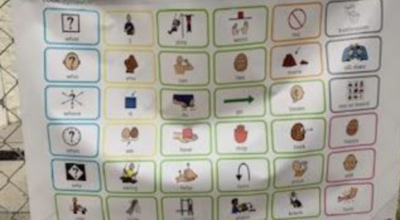NSDAR continues rich history
Published 12:57 pm Monday, April 8, 2019

Photo by Susan Parker
The Major George Gibson Chapter of the National Society of the Daughters of the American Revolution (NSDAR) holds its latest monthly meeting. From the left are: regent Agnes Marcum, vice-regent Mary Sprinkle, chaplain Rebecca Royal, recording secretary Augusta Sinon, corresponding secretary Linda Lawson, treasurer Charlotte Brooks, registrar Andrea Cheak, historian Rebecca Jones and parliamentarian Karen Fay Ramsey. Not shown is librarian Dolores Ham.
|
Getting your Trinity Audio player ready...
|
Since its founding in October of 1890, the National Society of the Daughters of the American Revolution (NSDAR) have gone about quietly preserving history, promoting patriotism and educating the general public on all things America.
The tradition is certainly alive and well in this region of the country, as the Major George Gibson Chapter of the NSDAR continues its rich tradition as a go-to for those interested in learning more about the founding years of our country.
The local chapter met recently at the Flatwoods UMC Church in Jonesville, Virginia. Andrea Cheak presented information surrounding the controversial concert by the famed contralto Marian Anderson.
Apparently, the singer’s manager ran upon a brick wall of sorts when he tried to book Anderson at the DAR Constitution Hall. As an African-American, Anderson was barred from performing in 1939, during the height of segregation in this country.
The manager, along with the NAACP and Howard University, petitioned the DAR to make an exception to their “white performers only” policy. The DAR declined.
The manager found roadblocks when attempting to book the singer into a local high school, as well.
Following the incident, first lady Eleanor Roosevelt resigned her membership in the DAR in protest. Roosevelt invited the singer to perform at the White House.
At this time, Anderson came under considerable pressure from the NAACP to refuse any invitations to perform for segregated audiences.
However, the first lady and the Marian Anderson Committee managed to convince the contralto to perform a concert on the steps of the Lincoln Memorial. The event took place on April 9, 1939 – Easter Sunday.
The DAR later apologized to Anderson, welcoming her to Constitution Hall on several occasions. The singer starred during a War Relief benefit concert in 1942.
After the passage of the Civil Rights Act of 1964, she chose Constitution Hall as the place to launch her farewell American Tour.
The DAR awarded Anderson the Centennial Medallion in 1992, honoring her as one of those women who have shown outstanding service to the nation.
In 2005, the DAR co-hosted the ‘first day of issue’ dedication ceremony with the United States Postal Service, where Anderson was honored with a commemorative stamp.
Agnes Marcum presented a program during the meeting on water and energy conservation. Marcum said that less than two percent of the earth’s water supply is fresh water. Of that, only one percent is available for drinking.
Marcum suggested practicing conservation by watering lawns only when really needed, and only during early morning or evening. Use a broom, rather than a water hose, to clean driveways and sidewalks, she said.
Other water-saving tips include using a bowl of water, rather than running water, to clean fruits and vegetables and avoiding flushing the toilet unnecessarily, especially to dispose of tissues, insects or similar waste.
Marcum suggested drinking from a reusable water bottle and storing drinking water in the refrigerator, rather than wasting water by running the tap until the water is cooled.
According to Marcum, the U.S. represents 4.5 percent of the world’s population, yet consumes over 25 percent of the oil produced worldwide. A 1 degree change in the thermostat setting can save 514 kilowatts per hour (kwh) each year, she said.
The entire life cycle of bottled water uses fossil fuels and causes pollution. Marcum pointed to a few energy tips like exchanging CFL bulbs for LED ones and changing laundry settings to ‘cold/cold.’ She suggested clearing vents and unplugging devices, when not in use. Using a power strip and turning off lights when not in use are other energy saving options.
Marcum said opening drapes and blinds during the day and closing them each night could also save energy.
Take the stairs, buy locally and recycle, she added.
The DAR chapters have spent much time raising funds to initiate several historic preservation and patriotic endeavors. The practice of installing markers at the graves of Revolutionary War veterans, and adding small flags at their gravesites on Memorial Day, was begun by DAR.
The nonprofit organization has commissioned and installed monuments to battles and other sites related to the Revolutionary War. DAR has spent time and money recognizing women patriots and their contributions alongside those of soldiers. For instance, DAR installed a monument at the site of a spring where Polly Hawkins Craig and other women carried water to use against flaming arrows in the defense of Bryan Station, located in Lexington, Kentucky.
The chapters have purchased, preserved and operated several historic houses and other sites associated with the Revolutionary War.
Following is a list of other accomplishments made by DAR chapters:
• The DAR Museum was founded in 1890 as a repository for family treasures. Today, the museum contains over 30,000 historical relics that form a collective memory of the decorative and fine arts in America from 1700-1850.
• The DAR Library was founded in 1896 as a collection of genealogical and historical publications for the use of staff genealogists verifying application papers for the National Society Daughters of the American Revolution. Shortly after 1900 the growing collection was opened to the public and has remained so ever since.
• The U. S. Army appointed DAR member, Dr. Anita Newcomb McGee, as Acting Assistant Surgeon, U. S. Army, in charge of nurses. She organized the DAR Hospital Corps, Army Nurse Corps, and served as NSDAR’s first Librarian General.
• The DAR Hospital Corps certified 1,081 nurses for service during the Spanish–American War. DAR later funded pensions for many of these nurses who did not qualify for government pensions.
• During the Spanish–American War, DAR purchased a ship’s tender for the USS Missouri to be used as a hospital launch for transporting the wounded from shore to ship.
• To help with the war effort during World War I, DAR loaned its National Headquarters land to the United States. The federal government used the land to erect a temporary war office building that provided office space for 600 people.
• After World War I, DAR funded the reconstruction of the water system in the village of Tilloloy, France, and donated more than $130,000 for the support of 3,600 French war orphans.
• DAR provided materials for sewing, wood, and leatherwork to the immigrants detained for processing on Ellis Island. This helped to alleviate the depression and anxiety of these men and women who were strangers in a new land.
• [27] In 1921, DAR compiled and published the “DAR Manual for Citizenship.” DAR distributed this guide to American immigrants at Ellis Island and other ports of entry. To date, more than 10 million manuals have been distributed.
• From November 1921 until February 1922, world leaders met in DAR Memorial Continental Hall for the Conference on Limitation of Armaments, a groundbreaking meeting for peace.
• The Americana Collection, founded in the early 1940s, brought together rare manuscripts and imprints previously scattered among the holdings of the DAR Museum and DAR Library. Today, the collection flourishes from more than 60 years of actively seeking out and acquiring artifacts that reflect a unique image of our nation.
• DAR raised thousands of dollars to assist in the re-forestation project of the U.S. Forest Service during the 1940s.
• During World War II, DAR provided 197,000 soldiers with care packages and sponsored all 89 crews of Landing Craft Infantry ships.
• During World War II, the use of the DAR buildings was given to the American Red Cross. A children’s day nursery was set up in the basement of Constitution Hall for enlisted men’s wives who had to go to work.
• The tradition of celebrating the Constitution was started many years ago by the Daughters of the American Revolution. In 1955, the DAR petitioned Congress to set aside September 17–23 annually to be dedicated for the observance of Constitution Week. The resolution was later adopted by the U. S. Congress and signed into Public Law #915 on August 2, 1956, by President Dwight D. Eisenhower.
At last count, there are over 180,000 members and 3,000 chapters worldwide. DAR is one of the largest and most active service organizations across the globe. Any woman age 18 years or older, regardless of race, religion or ethnic background, is eligible for membership if she can prove lineal descent from a patriot of the American Revolution.
For more information, log onto: www.dar.org.






